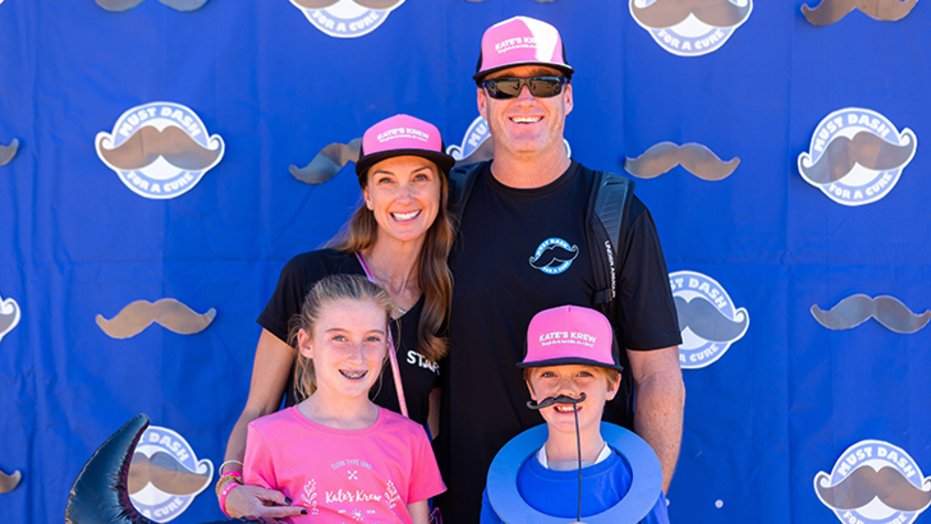
Quick tips for safe trick-or-treating
Before your goblins go door to door, consider these tips to keep them healthy and safe.
As she placed herself directly in front of the soccer goal, seemingly unaware of or, at least, unbothered by the surrounding defenders jostling for position around her, forward Kate Green was ready for the corner kick headed her way.
Her teammate raised her arm, signaling she was about to loft the ball through the air, and Kate watched as it flew toward her. With a perfectly timed strike, Kate's foot connected with the ball, launching it into the back of the net and winning the game with just 23 seconds to spare.
Living an active life with Type 1 diabetes
Much like the corner kick, Kate, 11, has proven to be ready for most things life sends her way. This includes the Type 1 diabetes diagnosis she received almost exactly three months prior to her game-winning goal.
Kate looks like your typical fifth-grader. Often surrounded by a group of laughing girls on the school playground and always game for a trip to the frozen yogurt shop or an impromptu sleepover, Kate is happy and kind, a hard-working student, quick to laugh and always willing to help.

Kate, a competitive soccer player and dancer in a local performance company, has managed to continue doing the activities she loves with the help of her family and her exceptional care team.
She is also an elite soccer player and lead dancer in a local performance company. She volunteers to tutor first- and second-graders and is active in her church. You would think a diagnosis like Type 1 diabetes — sometimes simply referred to as Type 1 or T1 — might bring Kate's active life to a screeching halt. But Kate and her family were uncommonly prepared for what was to come.
A family history and a shared commitment
Kate's paternal grandfather has lived with Type 1 the majority of his life. Close family friends have two children with the disease and the youngest, a boy, is best friends with Kate's younger brother, Garrison, so he often spends time with Kate's family. The Greens became accustomed to monitoring his blood sugar levels and carefully considering what he eats while with them. They also knew how to recognize the warning signs of when he wasn't feeling well.
The whole family has attended the local Juvenile Diabetes Research Foundation (JDRF) One Walk for years. Brooke has also volunteered at a community event in the San Marcos area called Must Dash for a Cure, a walk to benefit JDRF, since its inception.
Brooke knew what a diagnosis of Type 1 diabetes meant — that the person's pancreas has stopped producing insulin, the hormone that controls blood sugar levels. She also knew the T1 statistics — about 200,000 Americans under age 20 have Type 1 diabetes — and, most importantly, the warning signs of T1.
Knowing the signs of T1 diabetes
"Kate has always been petite," Brooke says. "But one night, as I was putting her to bed, the light from the lamp on her nightstand hit her at such an angle that my first thought was how sunken her face looked and that set off a little alarm. Around the same time, I noticed that she wasn't eating much — certainly not enough to fuel all her activity — and I even Googled, 'how much should a 10-year-old eat.'"
Brooke also noticed other signs that something wasn't quite right. Kate seemed constantly thirsty. Brooke would send Kate to school with a full water bottle that was coming home empty at the end of the day, when in the past it had often remained partly full. Kate also woke several times at night to go to the bathroom, which Brooke attributed to the increased water intake, but still seemed unusual.
The sudden weight loss, extreme thirst and frequent urination were all red flags that Brooke recognized as signs of Type 1 diabetes.
"The most common warning signs of Type 1 diabetes in children include frequent urination, increased thirst, dry mouth, change in appetite, unexplained weight loss, fatigue and yeast infections," says Dr. Michelle Vanstone, a pediatric endocrinologist affiliated with
Sharp Rees-Stealy Medical Group. "They may appear slightly ill, with vague complaints, such as being constantly tired. Other symptoms of diabetes in children can include changes in vision, as high blood sugar levels can lead to blurred vision or other eyesight problems."
Suspicions confirmed
Bracing herself for the diagnosis Brooke felt certain to come, she took Kate to her pediatrician's office and voiced her concerns. While the doctor, not her usual care provider, cautioned Brooke about jumping to conclusions, they agreed to test Kate's blood sugar levels.
Brooke's fear was later confirmed — Kate had Type 1 diabetes. However, because Brooke had noticed the signs earlier than most parents might, Kate's pancreas was still producing small amounts of insulin, she was not dehydrated, she was still happily participating in all her activities — including several hours of soccer and dance each week — and she did not feel or appear ill, as many children do before receiving a similar diagnosis.
"Although the signs of diabetes can begin to show in the early stages of the disease, sometimes it takes a while to recognize the symptoms. This often makes it seem like the signs and symptoms of diabetes appeared suddenly," Dr. Vanstone says. "Though uncommon, some children will be diagnosed before they experience symptoms, which typically occurs in children who have another close family member with Type 1 diabetes and an early diagnosis is made by a family member who suspects the child may be experiencing symptoms."
Brooke was certainly highly suspicious and once her diagnosis was confirmed, she was instructed to take Kate directly to the hospital, where the next chapter of her life — the post-T1 diabetes diagnosis chapter — began.
A crash course in blood sugar management
Over three days in the hospital, Kate and her parents were visited by a series of specialists. They met with doctors, nurses, a nutritionist, a social worker, a patient advocate, educators and a pediatric endocrinologist.
The Greens learned about managing Kate's diabetes with insulin — how it would be administered, the frequency Kate would need it and the dosage appropriate for her. They learned how to monitor Kate's blood sugar levels, which will change throughout the day, and how to react to correct high blood sugar with the right amount of insulin or low blood sugar with a certain amount of carbohydrates.
They all were taught about the importance of Kate's diet and exercise, which, in Kate's case, was far more than average. This meant they needed to ensure Kate ate enough to fuel her activities, but also ate the right kinds of foods and avoided empty carbs.
"We received lots of monitoring and lots of education during the time Kate was in the hospital," Brooke says. "It was like drinking water from a firehose — completely overwhelming. I was upset, stressed, scared, sleep-deprived, you name it, but I knew the more we learned and practiced what we were learning, the better we all would feel."
How diabetes can affect a family
Recognizing how they all felt about Kate's diagnosis was very important. It was obvious from the start that it wasn't just Kate that would be affected.

Kate and her family — Brooke, Ryan and younger brother Garrison — once again participated in the Must Dash for a Cure, a walk and run to benefit Type 1 diabetes research, though this was the first time Kate was honored at the event as someone impacted by the disease.
Garrison, her 8-year-old brother, was very upset. He had watched his friend deal with diabetes and knew it wasn't easy. He was worried about Kate and also worried about himself, wondering, "Will I get T1 too?"
Kate's dad, Ryan, grew up watching his father manage his own T1 diabetes. He was used to the meal schedules and restrictions diabetes demanded, and understood how to monitor blood sugar levels. However, he was crushed for his daughter, knowing the changes and challenges the disease would bring.
Brooke was also heartbroken for Kate, but determined to help Kate live her best life and continue doing the things she loves to do.
"T1 requires a lot of planning, but we're planners by nature," she says. "There are a lot of alarms to be set to remind us to check Kate's numbers, a lot of snacks to pack wherever we go and, of course, Kate's insulin and a glucagon injection, to be used in case of emergency, is always with her."
The family's schedule was also affected. Brooke and Ryan cleared their calendars of most everything but work to ensure one of them was always available and within close proximity of Kate in case she needed help at school or during one of her activities. In the meanwhile, family and friends stepped in to help keep Garrison busy, carpooling him to baseball practices and setting up play dates.
Continuous glucose monitoring and the new normal
Kate missed very little school after her diagnosis, only occasionally leaving to attend appointments with care providers or because she had to step out of class to check her numbers, get a quick snack or take her insulin. All in all, she was back at school, on the soccer field and in her dance classes within days of being discharged from the hospital.
This was due in part to the family's determination to return Kate to her normal 11-year-old's life and also because Kate was fortunate enough to receive a continuous glucose monitoring system, which made managing her diabetes easier. The sensor attaches to Kate's skin and tracks her glucose levels at all times. It transmits her glucose readings to a mobile receiver or smartphone, which allows Kate, her parents or whoever is with her — friends' parents, coaches, dance instructors and grandparents — to monitor her numbers and react appropriately with insulin treatment or nutrition, if needed.
While Kate was initially scared about her diagnosis, she is able to see that the negative effects it has had on her life are also balanced with some positives.
An 11 year-old's view on life with T1
"I don't like that my monitor beeps in school because everyone looks at me and I sometimes have to leave the classroom," Kate shares. "I also have to carry a backpack with me at all times and can't just eat carbs without thinking about how it will affect my numbers. But the good part is that I got to get a cellphone, which was awesome, and get to eat candy in class when my numbers are too low."
While Kate enjoys the additional treats — usually Skittles or bite-sized peanut butter crackers — it does bother her that some people think that eating too many sweets was the reason she got diabetes. It is a common fallacy that people with Type 1 diabetes became sick because of poor eating habits but it is actually an autoimmune disease likely caused by genetic predisposition. They might be confusing T1 with Type 2 diabetes, most often caused by obesity and lack of physical activity, though genetics and lifestyle also play a role.
Kate was also concerned her friends wouldn't want to hang out with her because of the things she needs to carry with her and constant monitoring of her numbers. She couldn't have been more wrong.
Within days of learning about Kate's diagnosis, her soccer teammates and dance studio friends formed a team to participate in the Must Dash for a Cure in her honor. Dozens of people in bright pink "Kate's Krew" T-shirts and hats took to the event's track to raise funds for JDRF and show Kate how much they care.

Kate's soccer and dance friends and their families came together to form "Kate's Krew" in the days following her diagnosis and many participated in the Must Dash for a Cure wearing bright pink — Kate's favorite color — in her honor.
"We chose not to keep Kate's diagnosis hidden," Brooke says. "We had to immediately deal with it and our extended family and friends did, too, which helped us feel more normal. We jumped right back into life, which was the best thing for Kate and our family."
Type 1 diabetes is life-changing, not life-ending
As the Greens found, a diagnosis of Type 1 diabetes is a life-changing event. However, according to Dr. Vanstone, with proper care and disease management, patients with Type 1 can live long, happy lives.
"Advancements in insulin delivery methods, specifically insulin pumps and continuous glucose monitors, give families the freedom to choose which treatment options work best with their lifestyle," she says. "The technology allows Type 1 diabetes to be a manageable part of a family's life, with the flexibility that can allow a family to participate in all the aspects of childhood and adolescence that are meaningful to them."
Brooke agrees — a T1 diagnosis is not the easiest challenge you'll face, but one families can get through together. She encourages parents of T1 kids to give themselves grace and not be hard on themselves.
"You're going to make mistakes, but they're not likely to be life-threatening ones," she says. "Call in all your resources. Ask for help when you need it. Advocate for yourself and your child. A diagnosis of T1 is life-altering, but completely manageable and life can go on as usual."
For Kate, this means that she will continue to play in the soccer championships, always at the ready for the next game-winning goal, as well as continue to do well in school, dance, be a good friend and continue to be a T1 hero for other kids who've received a similar diagnosis.
"If I met another kid who was diagnosed with Type 1, I'd tell them that it is going to be OK," she says. "It's not that bad and I'm here to go through it with them."

The Sharp Health News Team are content authors who write and produce stories about Sharp HealthCare and its hospitals, clinics, medical groups and health plan.

Dr. Michelle Vanstone is a pediatric endocrinologist affiliated with Sharp Rees-Stealy Medical Group.
Our weekly email brings you the latest health tips, recipes and stories.